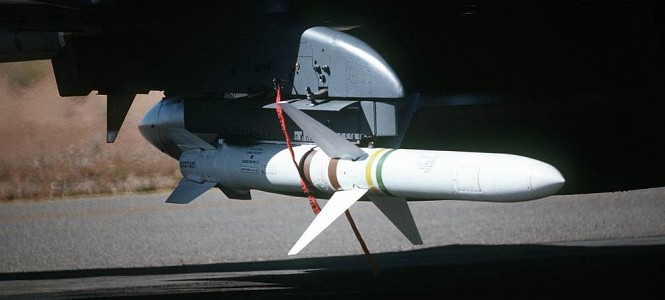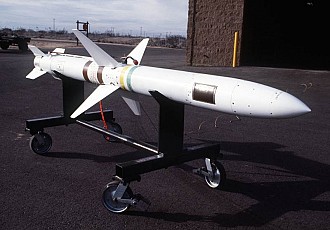Munitions / Air to surface missiles / AGM-45 Shrike
AGM-45 Shrike
General Facts
- TYPE
Anti-radiation missile - ORIGIN
 United States
United States - NICKNAMES
ASM-N-10 (early designation) - DESIGNED
1958 - 1963 - DESIGNER
Naval Weapons Center - PRODUCTION
- 1982 - PRODUCERS
 United States - Texas Instruments
United States - Texas Instruments - QUANTITY
About 18.500 - UNIT COST
About $ 7.000 - CHARACTERISTICS
 Very low production cost
Very low production cost
 Parts commonality with Sparrow
Parts commonality with Sparrow
 Different seeker for each radar band
Different seeker for each radar band
 Strict engagement envelope
Strict engagement envelope
 Low warhead effectiveness
Low warhead effectiveness
 Smaller range than most SAM systems
Smaller range than most SAM systems
Introduction
The AGM-45 Shrike is an anti-radiation missile of US origin. It was developed in the early 1960's to counter Soviet SAM systems such as the SA-2 Guideline. The Shrike was the first dedicated anti-radiation missile developed in the United States. Even with the introduction of the AGM-78 Standard ARM in US service the Shrike was retained for its low unit cost. Nowadays it is considered an obsolete weapon due to its low effectiveness.
Design
The Shrike is based on the AIM-7 Sparrow missile but is fitted with a different guidance section, blast fragmentation warhead and smaller tail fins. The layout is also similar to the Sparrow with most of the body made up of the single stage solid fuel rocket motor at the rear, the warhead in the middle and the guidance section at the front. The AGM-45A is based on the early AIM-7C missile, while the later AGM-45B uses the
Guidance
The Shrike uses a passive radar homing guidance section. The limited capability guidance section is considered the weakest part of the design. A total of 12 guidance sections are available, each set up to target radars operating in a different spectrum. This means that once the aircraft is airborne only a certain type of radar system can be engaged. The seeker also allows for a maximum of 3 degree deviation from the target, required precise attack vector. When the target radar is turned of the Shrike will miss since it cannot compute the last known radar location. These factors all contribute to the low success rate of the Shrike, which never exceeded 25 percent.
Firepower
The Shrike is fitted with one of six available warheads which are all of the blast fragmentation type and weigh about 66 kg. Most radar systems are rendered inoperational after a direct hit, but strikes against larger systems may result in loss of the antenna only. Due to the fragmentation effect that leaves most of the structure intact it is difficult to visually determine the effectiveness, resulting in uncertainty about the success of the strike. When fired from high altitude the AGM-45A may target radars out to 16 km, which is well within the range of most SAM systems. The much more powerful AGM-45B has a range of up to 40 km.
Platform
The Shrike can be launched from a variety of US aircraft including the A-4 Skyhawk, F-4 Phantom, F-16 Fighting Falcon, A-7 Corsair, A-6 Intruder and F-105 Thunderchief. Foreign aircraft capably of usin the Shrike were the Kfir fighter and Vulcan B-2 bomber and in I. A ground launched variant was developed in Israel and is known as the Kilshon, although the name Kachlilit is sometimes used as well. The Kilshon system uses a turretless M4 Sherman hull that mounts a single launcher for a modified Shrike with larger booster to provide the desired range.
Users
The main users of the Shrike were the US Air Force and the US Navy. The Shrike was exported to several nations with good ties with the USA. The Shrike was widely used during the Vietnam war and many subsequent conflicts. Due to its low cost it was retained in US service until 1992. The Shrike has also been used with varying success during the Falkland war and various Middle Eastern conflicts.
AGM-45 Shrike
The AGM-45 Shrike is an anti-radiation missile based on the body of the AIM-7C Sparrow air to air missile. The original AGM-45A uses the Mk 38 rocket motor as used in early versions of the Sparrow missile. The later AGM-45B uses the more powerful Mk 58 engine and has a much longer range. The AGM-45B also uses later versions all three blast fragmentation warhead options.
| Type | Anti-radiation missile |
|---|---|
| Diameter | 203 mm body, 914 mm wingspan, 457 mm finspan |
| Length | 3.05 m |
| Weight | 177 kg |
| Guidance | 12 different passive radar homing guidance sections available |
|---|---|
| Warhead | Mk 5 Mod 0, Mk 81 Mod 0 or WAU-8/B, 66.6 to 67.5 kg blast fragmentation warhead |
| Propulsion | Rocketdyne Mk 38 solid fuel rocket motor |
| Speed | Mach 2 |
| Range | 12 km, up to 16 km from high altitude |
|---|---|
| Altitude | - |
| Engagement envelope | Max 3 degree deviation from target |
| Remarks | - |
| Type | Anti-radiation missile |
|---|---|
| Diameter | 203 mm body, 914 mm wingspan, 457 mm finspan |
| Length | 3.05 m |
| Weight | 177 kg |
| Guidance | 12 different passive radar homing guidance sections available |
|---|---|
| Warhead | Mk 5 Mod 1, Mk 81 Mod 1 or WAU-9/B, 66.6 to 67.5 kg blast fragmentation warhead |
| Propulsion | Hecules Mk 58 dual-thrust solid fuel rocket motor |
| Speed | Mach 2 |
| Range | Up to 40 km |
|---|---|
| Altitude | - |
| Engagement envelope | Max 3 degree deviation from target |
| Remarks | - |


